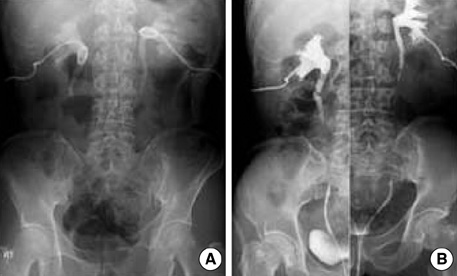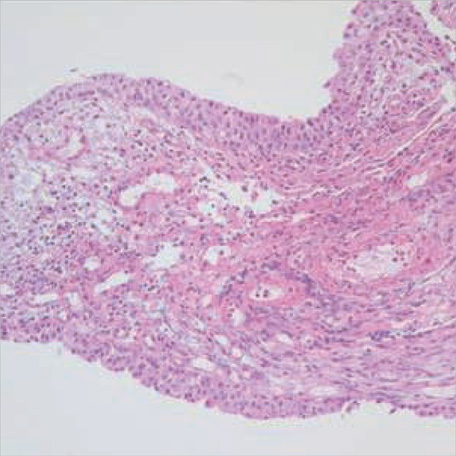J Korean Med Sci.
2010 Apr;25(4):644-646. 10.3346/jkms.2010.25.4.644.
Multiple, Bilateral Fibroepithelial Polyps Causing Acute Renal Failure in a Gastric Cancer Patient
- Affiliations
-
- 1Department of Urology, Chonnam National University Medical School, Gwangju, Korea. sydad@hanmail.net
- KMID: 1792941
- DOI: http://doi.org/10.3346/jkms.2010.25.4.644
Abstract
- We report a case of primary fibroepithelial polyps (FEPs) in the middle of both ureters in a patient with advanced gastric cancer and acute renal failure. Ureteral FEPs are rare benign lesions, and multiple, bilateral lesions are extremely rare. To our knowledge, this report is the seventh case of bilateral FEPs in the literature. Our case has clinical implications because FEPs should be considered as a cause of ureteral obstruction inducing acute renal failure in advanced gastric cancer.
Keyword
MeSH Terms
Figure
Reference
-
1. Franco I, Choudhury M, Eshghi M, Bhalodi A, Addonizio JC. Fibroepithelial polyp associated with congenital ureteral diverticulum: report of 2 cases. J Urol. 1988. 140:598–600.
Article2. Kiel H, Ullrich T, Roessler W, Wieland WF, Knuechel-Clarke R. Benign ureteral tumors. Four case reports and a review of the literature. Urol Int. 1999. 63:201–205.3. Mariscal A, Mate JL, Guasch I, Casas D. Cystic transformation of a fibroepithelial polyp of the renal pelvis: radiologic and pathologic findings. AJR Am J Roentgenol. 1995. 164:1445–1446.
Article4. Liddell RM, Weinberger E, Schofield DE, Pelman RS. Fibroepithelial polyp of the ureter in a child. AJR Am J Roentgenol. 1991. 157:1273–1274.
Article5. Van Poppel H, Nuttin B, Oyen R, Stessens R, Van Damme B, Verduyn H. Fibroepithelial polyps of the ureter. Eur Urol. 1986. 12:174–179.6. Lavelle JP, Knisely AS, Bellinger MF. Benign fibroepithelial polyps causing symptomatic bilateral intermittent hydroureteronephrosis. J Urol. 1997. 158:569.
Article7. Psihramis KE, Hartwick W. Ureteral fibroepithelial polyp with positive urinary cytology. Urology. 1993. 41:387–391.
Article8. Cassar Delia E, Joseph VT, Sherwood W. Fibroepithelial polyps causing ureteropelvic junction obstruction in children-a case report and review article. Eur J Pediatr Surg. 2007. 17:142–146.9. Bartone FF, Johansson SL, Markin RJ, Imray TJ. Bilateral fibroepithelial polyps of ureter in a child. Urology. 1990. 35:519–522.
Article10. Bolton D, Stoller ML, Irby P 3rd. Fibroepithelial ureteral polyps and urolithiasis. Urology. 1994. 44:582–587.
- Full Text Links
- Actions
-
Cited
- CITED
-
- Close
- Share
- Similar articles
-
- Two Cases of the Multiple Fibroepithelial Polyps of the Ureter
- Giant Fibroepithelial Polyp in the Renal Pelvis to the Upper Ureter
- A Case of Bilateral Fibroepithelial Polyps of the Ureter
- Congenital Fibroepithelial Polyp of the Penoscrotal Junction
- Fibroepithelial ureteral polyp: a case report; endoscopic removal of large ureteral polyp




